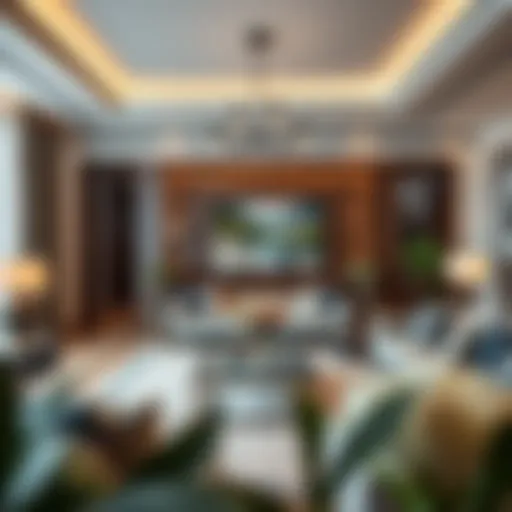UAE Towers: Architectural Wonders and Real Estate Influence
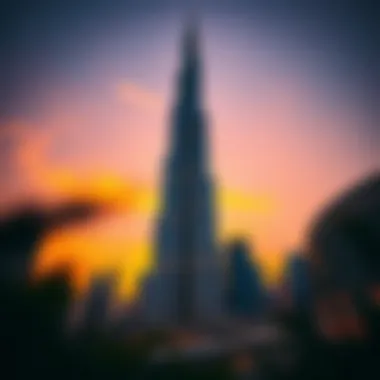
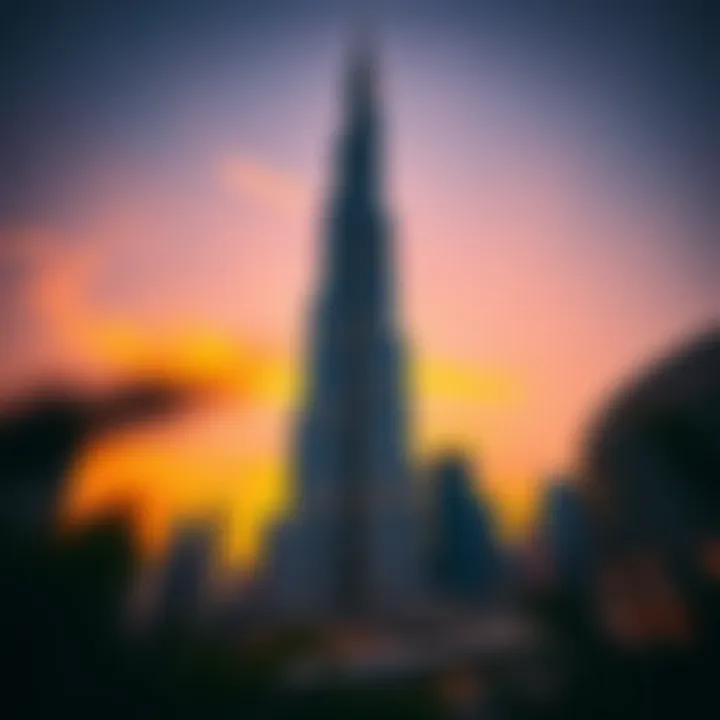
Intro
The United Arab Emirates (UAE) stands as a beacon of modernity and innovation in architecture, with its skyline dominated by soaring towers that contribute significantly to its identity. This article embarks on a detailed exploration of these architectural marvels, particularly focusing on Dubai, a city synonymous with bold and iconic structures. The influence of these towers goes beyond visual appeal; they play a crucial role in the real estate market and impact the economic landscape of the region.
The UAE's towers are not just buildings; they're a statement of ambition and vision. From the illustrious Burj Khalifa to the sleek lines of the Dubai Marina, each tower has a unique tale to tell. Understanding these narratives is paramount, especially for investors and homebuyers who seek to immerse themselves in the fabric of this dynamic market.
In this article, we will cover the architectural significance of these structures, their economic implications, and how they shape the urban environment. We will analyze trends in the real estate sector influenced by these towers and delve into investment opportunities that arise as a result. This comprehensive examination aims to provide insights essential for navigating the evolving property market in the UAE.
As we dive deeper into the layers of this topic, one thing becomes evident: The architectural prowess of the UAE towers not only attracts tourists but also lures significant investment, transforming the landscape of urban dwelling. Investors, homebuyers, and real estate agents will find this exploration valuable as we unpack the nuances of property values linked to the towering giants that populate the skyline.
Prelims to UAE Towers
The iconic towers of the UAE are not just structures of steel and glass; they represent a dynamic fusion of culture, ambition, and modernity within the region's rapidly evolving skyline. As real estate enthusiasts and investors alike turn their gaze toward the Middle East, understanding the story and significance of these towering marvels becomes paramount. The following sections will delve into how these buildings have redefined urban living and investment opportunities in the UAE, highlighting essential elements such as their architectural aesthetics, cultural implications, and economic impact.
Historical Context of Tower Development
The journey of skyscraper development in the UAE is intertwined with the nation's transformation from a modest collection of fishing villages into a global business hub. In the late 20th century, the construction of tall buildings began in earnest as cities like Dubai aimed to showcase their newfound wealth and ambition. The Burj Al Arab, completed in 1999, marked a pivotal moment in this evolution, as it symbolized luxury and opulence, captivating the world. The real estate boom that followed brought forth an impressive array of towers, from residential complexes to commercial giants, further boosting the UAE's image on the global stage.
The government played a crucial role, providing incentives and robust infrastructure to support such developments. This architectural race was not merely about height; each project sought to tell a unique story reflective of the UAE's cultural heritage and aspirations. Thus, the historical context reveals that every tower is more than just concrete and glass; it's a testament to the country's evolution and a beacon of future possibilities.
Significance in Modern Urban Landscape
Today, the UAE towers are critical elements in reshaping urban life. They dominate the skyline and foster an environment that attracts international investment and tourism—two lifebloods of the country's economy. The presence of structures such as the Burj Khalifa and One Za'abeel has transformed how cities function, allowing for vertical living and working spaces that maximize land efficiency. These towers facilitate not only residential and commercial space but also create vibrant communities, often coming equipped with amenities that improve quality of life.
Furthermore, these towering edifices influence not just the architectural palate but also the social dynamics of the region. They act as landmarks around which communities gather, serve as venues for entertainment and business, and symbolize the ambition driving the UAE's growth. The fusion of modern engineering and local culture in these designs works to create an urban narrative that is both unique and appealing to a global audience.
"The UAE towers are more than mere buildings; they are living expressions of an ever-advancing society, encapsulating history, cultural identity, and modernity."
In essence, understanding the significance of these towers is critical for investors, homebuyers, and real estate agents as they navigate the property landscape influenced by these architectural wonders. As we move forward in this exploration, one will recognize the intricate interplay between the towers, urban development, and real estate market dynamics that make the UAE a fascinating study.
Architectural Features of Prominent Towers
The towers in the UAE are not just mere structures but stand as testaments to architectural ingenuity and ambition. The way these buildings are designed reflects a blend of cultural identity, innovation, and sustainability, making them important landmarks that contribute significantly to both the skyline and the urban narrative.
The architectural features of these prominent towers can drastically influence their value and the perception of the surrounding real estate market. Their striking silhouettes often become synonymous with the cities they inhabit, affecting everything from tourism to property investments. These structures showcase advanced engineering, along with aesthetic considerations that encapsulate the essence of modern living, making them pivotal in attracting both residents and investors alike.
Burj Khalifa: An Icon of Innovation
Burj Khalifa, piercing the Dubai sky at a height of 828 meters, stands not only as a marvel of engineering but also as a beacon of what’s possible in the realm of architecture. Its design by Adrian Smith and his team at Skidmore, Owings & Merrill is inspired by the geometries of a desert flower, a nod to the region’s natural landscapes. This tower does more than scrape the clouds; it's a reflection of a futuristic vision that has shaped Dubai into a global hub.
The use of reinforced concrete and glass, along with the advanced energy systems in Burj Khalifa, represents a leap towards sustainability while ensuring safety in its grand structure. An observation deck on the 148th floor provides visitors with breathtaking panoramic views of the city and beyond, illustrating how the building serves both as a residential and an experiential space. Moreover, the tower’s sheer presence attracts investors and enhances property prices within its vicinity, creating a ripple effect across Dubai.
One Za'abeel: Vertical Living Redefined
Soaring high over the Dubai skyline, One Za'abeel is a shining example of vertical living, pushing the boundaries of modern architecture. This ambitious project includes the tallest hotel in the world, The Ardmore, alongside luxury residential units and commercial spaces. Designed by the globally recognized firm of Norman Foster, the structure possesses an imaginative flair that challenges traditional design principles.
With elegant curves and an innovative approach to space utilization, One Za'abeel embodies the notion of high-end urban living. Its double-decker elevators significantly enhance the efficiency of vertical travel, a crucial feature in such towering edifices. The considerable investment poured into sustainable technology, including the use of smart building materials, positions One Za'abeel as a front-runner in eco-conscious architecture.
Emirates Towers: A Blend of Culture and Modernity
Emirates Towers presents a fascinating study in contrasts. The design showcases a striking juxtaposition of glass and steel, embodying the modern spirit while still hinting at the rich cultural heritage of the UAE. Completed in the early 2000s, it consists of two towers: one for offices and the other for hotel accommodations. This structure effectively combines functionality with aesthetic appeal, addressing the needs of a diversifying urban population.
The towers are adorned with intricate Islamic motifs, allowing them to resonate culturally with the population while standing as symbols of progress. The connectivity between the towers through a beautifully landscaped plaza creates a vibrant community space that encourages interaction. Emirates Towers illustrates how architectural design can promote urban cohesion, enhancing the overall market value of the area surrounding them.
In essence, the architectural features of these towers serve as pivotal elements in shaping the real estate landscape, facilitating a dialogue between innovation, culture, and community in the UAE.
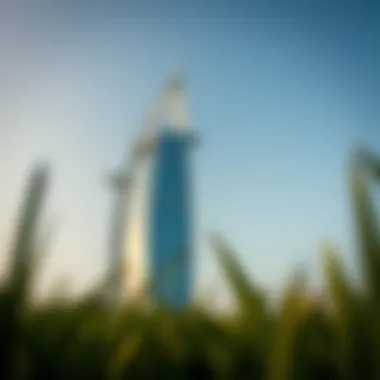
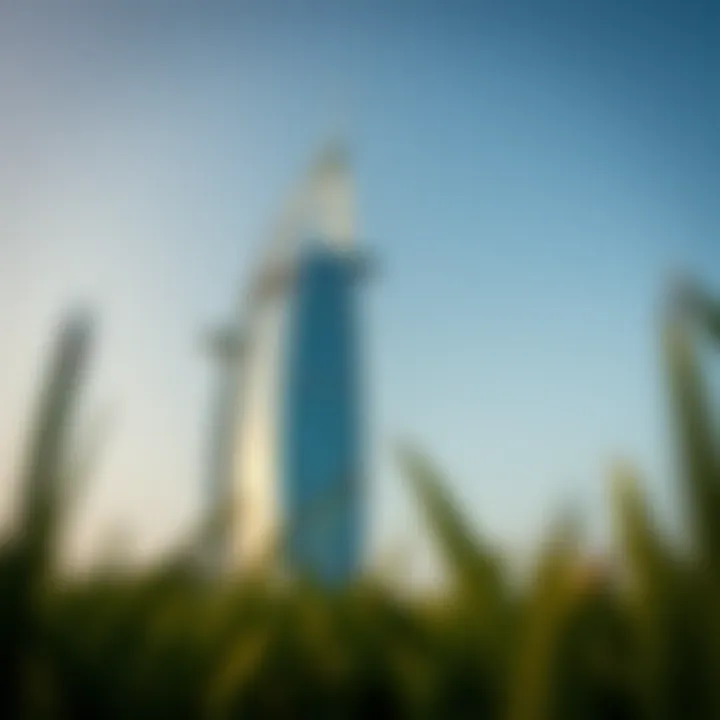
Economic Impact of Tower Development
The skyline of the United Arab Emirates, especially in cities like Dubai and Abu Dhabi, is a testament to architectural ambition and economic growth. The development of towers has not only redefined urban aesthetics but has also sparked a plethora of economic opportunities, reshaping the property landscape. As these architectural giants reach for the sky, one can’t help but wonder about their ripple effects on both local and international fronts.
Investment Opportunities Surrounding Tall Structures
Investing in towers is like prepping a fine dish; it requires a good mix of ingredients and timing. The real estate market in the UAE offers a smorgasbord of options for investors looking to capitalize on the ever-growing demand for luxury living. With iconic structures such as the Burj Khalifa and One Za'abeel attracting global attention, it’s clear that these towers serve as catalysts for further investment.
- Rental Yields: Towers tend to have high occupancy rates. Areas near prominent skyscrapers often see rental prices soar due to demand, offering attractive returns for investors.
- Commercial Opportunities: Tall structures often include commercial spaces that are sought after by businesses. The visibility and prestige associated with these buildings can lead to thriving enterprises.
- Tourism Boost: With towers becoming tourist attractions, from observation decks to luxurious hotels, investments here can tap both the residential and tourism sectors.
- Infrastructure Development: As towers rise, so does the infrastructure surrounding them. Investments in transportation and utilities typically follow, amplifying the economic benefits for stakeholders.
Influence on Property Pricing Strategies
Understanding how towers impact property prices is crucial for investors and homebuyers alike. The proximity to prestigious towers can alter the real estate pricing landscape significantly. Here's how:
- Perceived Value: Living near a tall tower often elevates the perceived value of surrounding properties. Few can resist the allure of residing in an area recognized for its architectural wonders.
- Market Trends: Skyscrapers often drive market trends, affecting both sales and rental prices. Properties in a vicinity that embodies a high-rise lifestyle tend to command higher prices.
- Luxury Segment Growth: Towers often cater to affluent residents and businesses, leading to a rise in upscale property developments nearby. This creates a ripple effect, lifting the overall property values in the region.
As the UAE continues to mature as a key player on the global real estate stage, it's crucial to grasp how tower developments fuel the engine of economic growth. The connection between these architectural marvels and the real estate market isn't merely observational; it's a robust, intertwined relationship that offers numerous opportunities for those ready to invest.
Cultural and Social Implications
The discussion around UAE towers goes beyond bricks and mortar; it delves into the very soul of the nation, intertwining culture, society, and identity. These towering structures are not just points on a skyline but are resonant symbols, each echoing tales of cultural narrative, innovation, and social change. Understanding the cultural and social implications of these architectural wonders is crucial, especially for investors and real estate professionals who seek to navigate this complex landscape.
Cultural Representation in Architectural Design
When one gazes over the skyline of Dubai or Abu Dhabi, the towers tell a story that integrates both the rich history and aspirations of the UAE. Each design element contributes to a narrative that resonates with local traditions and future ambitions. For instance, the Burj Khalifa isn't merely the tallest building in the world; it embodies ancient Islamic motifs and architectural principles while stretching towards modernity. The tower's sleek lines and upward thrust symbolize the UAE’s ambitions for progress while paying homage to its cultural heritage.
"Architecture is the will of an epoch translated into space" — Ludwig Mies van der Rohe
In other cases, structures like Etihad Towers reflect influences from art deco while maintaining a distinctly Middle Eastern flair. This blend offers visitors and residents alike a visual feast, allowing them to absorb the history of the UAE within the very fabric of the towers' design. Furthermore, these buildings often incorporate elements like water features and landscaped gardens, which connect urban life with nature—an important aspect of Middle Eastern culture.
This cultural representation serves not only as a beacon for tourists but also enriches the lives of residents who find identity and belonging within these spaces. The thoughtful integration of cultural symbolism within the architectural dialogue makes UAE towers a canvas illustrating the nation’s evolution and societal values.
Community Development Initiatives and Towers
The UAE towers also play a pivotal role in shaping community development. The government and private sector collaboration to create mixed-use spaces around these structures has transformed neighborhoods into vibrant ecosystems. For example, the Dubai Marina integrates residential, commercial, and recreational spaces, fostering a sense of community that was previously unseen in many towering urban environments.
These towers encourage social interactions through public spaces, parks, and amenities. Through initiatives like community events and arts festivals held in the shadow of these towering giants, residents have opportunities to engage, network, and build relationships. The societal shift towards connectedness is evident in how people flock to these areas, sharing experiences and creating community bonds.
On a more granular level, local businesses thrive on the foot traffic that towers attract, fostering entrepreneurship and economic development. This symbiotic relationship highlights the importance of towers in not just elevating the skyline, but also uplifting the community.
Ultimately, the cultural and social implications of the UAE towers paint a more comprehensive picture of their impact—a blend of identity, interaction, and innovation that enriches every aspect of urban life.
Sustainability and Environmental Considerations
Sustainability and environmental considerations are becoming increasingly pressing in today’s architectural landscape, especially in a dynamic region like the UAE. As towers rise to greet the heavens, they leave a substantial footprint on the Earth’s ecosystem. Emphasizing these elements ensures that development does not come at the cost of future generations. Building tall doesn’t just add space; it potentially redefines how communities interact with their environment. High-rise buildings can be designed with the earth in mind, marrying luxury and sustainability, blending modernity with responsibility.
Eco-Friendly Designs in New Developments
The move towards eco-friendly designs in new skyscrapers is more than just a trend; it reflects a fundamental shift in architectural philosophy. Innovative green building practices are being adopted across prominent developments, incorporating elements like energy-efficient systems, renewable energy sources, and sustainable materials. Structures such as the Burj Khalifa showcase energy-saving technologies including high-efficiency lighting and advanced water recycling systems, tackling resource inefficiency head-on.
Benefits of eco-friendly designs include:
- Reduction in Energy Consumption: Smart designs minimize energy use through passive solar heating and energy-efficient HVAC systems.
- Water Preservation: Collecting and filtering rainwater can significantly cut down on reliance on the local water supply.
- Reduced Waste: Using recyclable materials and planning for deconstruction minimizes the construction waste that ends up in landfills.
The excitement around eco-design is not merely academic. For investors and homebuyers alike, these kinds of innovations contribute significant value to properties. As emphasis on sustainability grows, so does the desirability of buildings that occupy this niche.
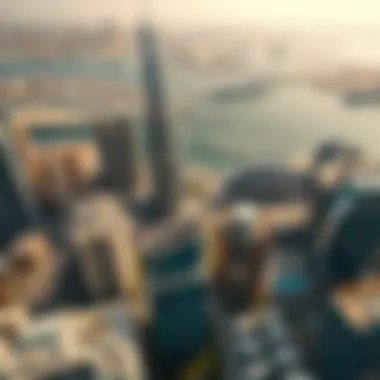
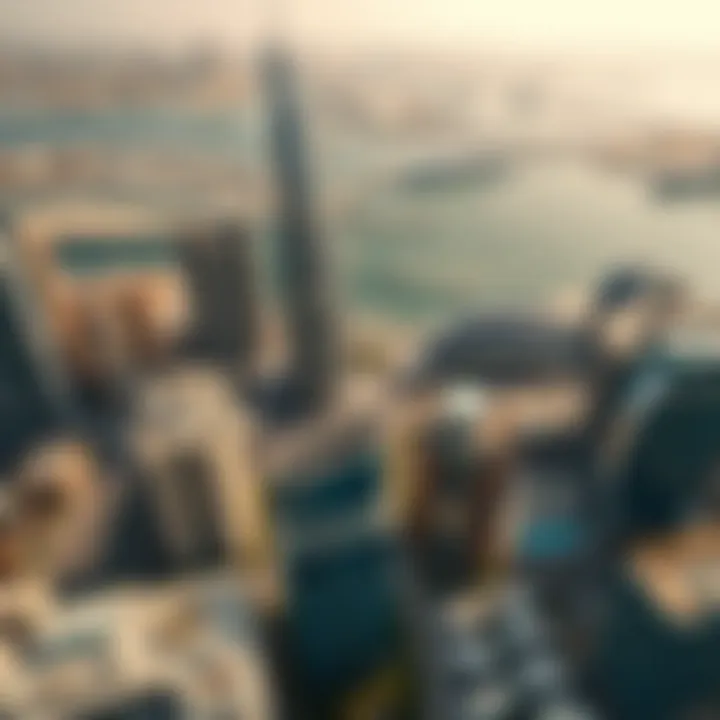
Vertical Green Spaces: An Emerging Trend
Vertical gardens and green spaces high above the ground are also emerging as stark indicators of a tower's commitment to the environment. Not only do they enhance the aesthetic appeal, but these green havens also offer various urban benefits. Integrating plants into high-rise designs can improve air quality and reduce the heat island effect prevalent in dense urban settings.
Considerations for vertical green spaces include:
- Biodiversity Promotion: These gardens can encourage local biodiversity, nurturing a variety of flora and fauna often lost in bustling city life.
- Thermal Comfort: Plants provide a natural cooling effect, decreasing the urban heat island impact and keeping surrounding areas cooler.
- Community Engagement: Green roofs can serve as tranquil retreats or gardens for nearby residents, fostering a deeper connection with nature right in the city.
"Incorporating greenery into high-rise buildings is not just about beautification; it's about creating a sustainable ecosystem that supports urban life."
The entry of vertical gardens in UAE towers signifies a forward-thinking approach to architecture. For investors and homeowners, this translates to a blend of lifestyle appeal and reduced environmental impact, turning buildings into living ecosystems rather than mere steel and concrete structures.
With climate consciousness becoming integral in urban planning, the UAE towers are setting a benchmark, perhaps pushing others around the globe to rethink their building philosophies.
Technological Advancements in Tower Construction
The evolution of tower construction technology has completely transformed the skyline of the UAE, especially in cities like Dubai. These advancements are not merely about reaching new heights but encompass a broad spectrum of innovative practices aimed at improved safety, sustainability, and efficiency. The incorporation of cutting-edge technologies is paramount in shaping not only the architectural beauty of these structures but also their long-term viability in a rapidly changing urban environment.
As investors or homeowners delve into real estate opportunities, understanding these advancements becomes essential. They provide insights into potential property values and the durability of investments. With the integration of high-tech features, investors can often foresee which structures will thrive and which may falter as the market and environmental standards evolve.
Innovative Materials and Techniques
The materials used in construction have seen significant innovation, reshaping both the aesthetics and functionality of towers. Traditional concrete and steel still play a vital role, but are increasingly being complemented by composite materials and self-healing concrete. For example, the Burj Khalifa uses a specially formulated concrete mix that allows it to withstand the harsh desert climate while offering superior structural integrity.
- Composite Materials: These materials combine different substances to produce something stronger and lighter, making construction more manageable and economical. This is especially beneficial for high-rise buildings where weight is a critical factor.
- Self-Healing Technology: An advancement that allows concrete to repair itself with minimal human intervention can decrease maintenance costs substantially, a feature that builders are finding increasingly appealing for longevity.
By employing these innovative materials, builders not only enhance the building's aesthetics but also contribute to sustainability by reducing the carbon footprint associated with traditional construction methods.
Smart Building Technologies and Integration
In the age of rapid technological growth, integrating smart building technologies has become a cornerstone of modern tower design. These systems include everything from automated lighting and heating to state-of-the-art security features.
- Energy Management Systems: Smart buildings often implement intelligent energy management, which optimizes energy usage in real-time, helping to reduce operational costs and environmental impact.
- IoT Integration: The Internet of Things plays a crucial role in maintaining seamless communication between various building systems. For instance, elevators can be programmed to respond to the peak traffic hours, enhancing the flow of occupants without delays.
"In the competitive arena of skyscraper development, smart technologies are no longer just a bonus, but a necessity that can significantly enhance property value and appeal".
Such advancements extend beyond mere convenience. They also create safer living environments and align with global sustainability goals. As potential homeowners or investors review options in the UAE's ever-expanding skyline, the importance of these technological integrations cannot be overstated. They not only promise enhanced efficiency but also proactively address environmental concerns, making them a significant consideration in real estate decisions.
UAE Towers as Tourist Attractions
UAE towers stand as more than just steel and glass structures; they pulse with life as emotive symbols of human ambition and creativity. They are not merely the focal points of the skyline but also significant tourist attractions that entice millions of visitors every year. These towering edifices offer unique experiences and a glimpse into the UAE’s architectural prowess, making them vital to the region's tourism strategy. As we delve into this topic, we see how these architectural marvels have shaped the visitor experience while boosting the local economy.
Visitor Experiences and Attractions
When one thinks of visiting Dubai or Abu Dhabi, towering structures instantly come to mind. Each tower presents visitors with an opportunity to engage with the UAE’s ethos of luxury, opulence, and creativity. For instance, the Burj Khalifa serves as a case study in how a well-designed observation area can enhance the tourist experience. At 124 floors up, visitors are treated to an unobstructed panorama of the city, stretching all the way to the Arabian Gulf. There's something extraordinary about standing at such heights, where the hustle and bustle below seem far away, leaving individuals awash in the sheer beauty of the landscape.
Additionally, attractions like the Dubai Frame offer another layer of experience. This structure allows visitors to walk through the frame and witness both old Dubai and its progressive urban landscape. The sheer contrast featured within the Frame encapsulates the UAE’s transformation from humble beginnings to a thriving metropolis.
Moreover, themed towers like the Cactus Tower present a multi-sensory experience involving both visual spectacles and storytelling elements tied into their design. With cafes, museums, and art installations dotted across these structures, the towers become ecosystems of cultural exchanges that elevate the mundane activity of sightseeing into something meaningful. Tourists can marvel at intricate designs, while also diving into local history through immersive experiences that few towers around the world offer.
The Role of Towers in Promoting Tourism
As tourist attractions, these towers play a pivotal role in the UAE’s ongoing effort to elevate its image as a global tourism hub. Their uniqueness often serves as the foundation for marketing campaigns. Promotional content often highlights these towers' distinct attributes, positioning them as must-visit destinations.
Notably, events held at these towers—be it light shows, art exhibitions, or seasonal celebrations—serve to grab media attention, drawing in crowds eager to partake in these exclusive experiences. Such activities are strategically designed to make the most of the towers' architectural aesthetics, enticing visitors not just for their appearance but for the cultural activities they host.
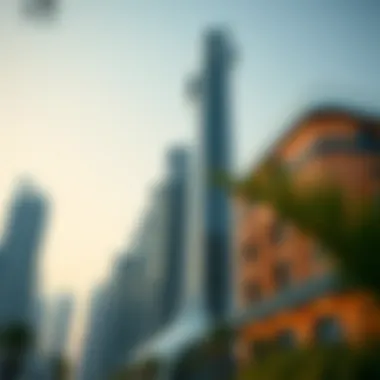
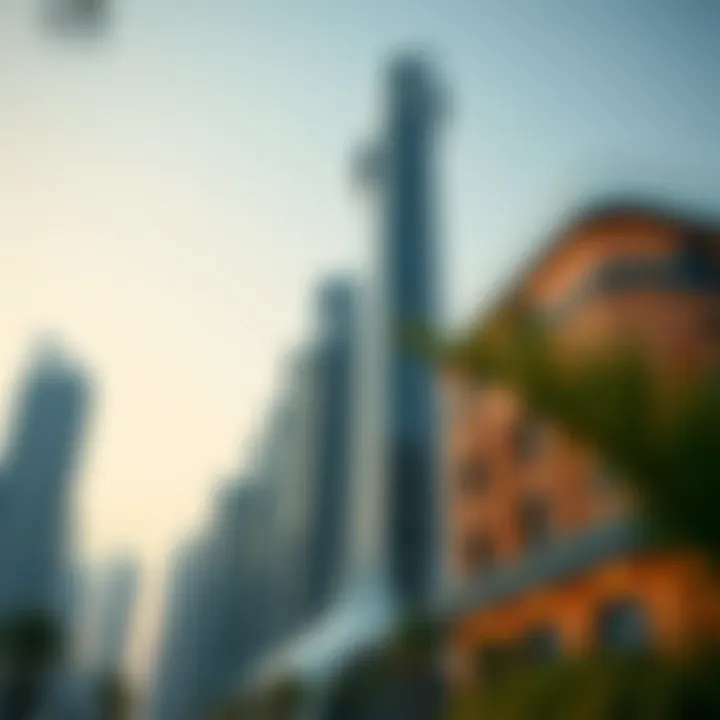
Furthermore, the availability of luxury hotels within or near these significant towers often leads to increased occupancy rates for the accommodation sector. This has a cascading effect on associated businesses such as restaurants, tour operators, and transportation services. The phenomenon is a classic example of how a well-placed architectural marvel can stimulate local economies and create a vibrant atmosphere for both tourists and residents alike.
Comparative Analysis with Global Towers
In the world of skyscrapers, competition is fierce, and the UAE has certainly made its mark on the global stage. This section delves into the importance of analyzing how UAE towers compare with global counterparts, shedding light on architectural elements, cultural reflections, and economic ramifications involved in such distinctions.
A comparative stance helps to highlight the strengths of the UAE's architectural ambitions while discerning how they resonate within a broader context of global development.
Contrasting Architectural Styles
When you stroll through the metro cities across the globe, one cannot help but notice the unique flavors of architectural styles that characterize different regions. Take New York's Empire State Building, with its Art Deco charm, and compare it to the smooth lines of Abu Dhabi's Etihad Towers — each one tells a different story of culture and aspiration.
In the UAE, the blending of modernity with traditional Arabian designs is a hallmark of its skyline. The Burj Khalifa stands tall not only as a structure of steel and glass but also as a statement of ambition. It fuses modern engineering with Islamic architectural elements, creating a unique juxtaposition unseen in many Western towers.
Consider also the One World Trade Center, which, just like Burj Khalifa, pays homage to the spirit of resilience but takes a markedly different approach in design philosophy. While both towers represent their cities' identities, they are structurally and aesthetically distinct. The diverse array of styles offers investors a rich narrative to consider when investing in real estate — each tower not only serves a functional purpose but also embodies a cultural identity and an architectural language.
The UAE's Place in the Global Skyscraper Race
As the sun rises over the bustling city of Dubai, the skyline is dotted with towers vying for global recognition. The UAE's position in the skyscraper race is not merely defined by the height of its buildings, but rather by the innovation and sustainability efforts that accompany these projects.
Today, the UAE ranks among the top countries for the tallest structures, aspiring to outdo itself in luxury and technology. From the record-breaking Burj Khalifa to the ambitious Jeddah Tower, which aims to surpass it in height, the standards are continually being pushed. The factors driving this competition are not just about aesthetics or height; they include considerations for sustainability, energy efficiency, and creating livable environments within urban landscapes.
"Architecture is a visual art, and the buildings speak for themselves." – Julia Morgan
As such, investors would be wise to heed the stories told by these structures, as they hold the keys to understanding not just the UAE's real estate dynamics but also those of the world at large.
Future of Tower Developments in the UAE
The future of tower developments in the UAE promises to be a fascinating blend of innovation, sustainability, and vertical expansion. As cities grow denser and land becomes more scarce, both domestic and foreign investments are poised to shift significantly towards skyscraper projects. Not only do these towers embody the aspirations of a nation seeking to dominate the architectural landscape, but they also represent vital economic opportunities for investors, homebuyers, and real estate agents.
Upcoming Projects and Trends
In the upcoming years, several ambitious projects are set to redefine the skylines of Emirates cities. Here is a look at some notable examples:
- Dubai Creek Tower: Aiming to surpass the Burj Khalifa, Dubai Creek Tower is designed to be a centerpiece of the Dubai Creek Harbour development. With its unique twist in architectural design and integrated greenery, it's anticipated to create a spectacular visual impression.
- Jeddah Tower: Although located across the border, this project impacts UAE developers. As the tallest tower in the world, it influences architectural trends and investment strategies region-wide.
- Sustainable Towers: Developers are increasingly focusing on eco-friendly designs. New towers incorporate solar panels, rainwater harvesting systems, and vertical gardens, thereby enhancing energy efficiency and reducing environmental footprints.
The trend towards smart buildings cannot be overlooked. Properties integrated with Internet of Things (IoT) technologies provide better management and optimization of resources, catering to both residential and commercial needs. This enhanced engagement with digital infrastructure indicates greater collaboration between tech firms and construction companies seeking synergy in modern projects.
Potential Challenges Ahead
While the future seems bright, there are challenges that developers must navigate. Below are a few hurdles that could influence tower projects in the UAE:
- Economic Fluctuations: As seen with the downturns in the global economy, fluctuations can affect investor confidence and funding mechanisms. Developers need to remain agile and responsive to these changes in the economic landscape.
- Regulatory Hurdles: Stricter regulations regarding building codes and sustainability standards can pose challenges. While they enhance safety and environmental responsibility, they can also complicate the approval process for new projects.
- Market Saturation: Increasing numbers of high-rise developments might lead to an oversupply in certain markets. Proper market analysis and strategic planning will be essential for mitigating risks associated with too many similar properties.
"The sky is not the limit; it's just the beginning of what's possible for UAE's architectural future."
Culmination
The towers of the UAE, from the sleek Burj Khalifa to the culturally infused Emirates Towers, form a skyline that speaks volumes about the region's aspirations and achievements. They are not merely structures made of concrete and steel; they are symbols of innovation, economic growth, and urban transformation. This article has explored various dimensions of these architectural marvels, elucidating their impact not only on the skyline but also on the real estate landscape of the UAE.
Recap of Key Insights
Throughout our journey, we have uncovered several critical insights:
- Architectural Brilliance: The distinctive styles and features of each tower, such as the innovative use of eco-friendly materials and cutting-edge technologies, emphasize the UAE's commitment to pioneering design.
- Economic Influence: Tower development has directly correlated with inflated real estate prices and novel investment avenues, attracting local and international investors alike.
- Cultural Impacts: Beyond aesthetics, these towers represent the cultural ethos of the Emirates, intertwining modernity with local heritage, which can be seen in various design elements.
- Future Outlook: Upcoming projects promise even more excitement and transformation, with potential challenges laying hurdles that need addressing for sustained growth.
"The skyline of the UAE is a canvas where art and engineering converge, signaling the relentless drive of the nation towards greatness."
Final Thoughts on UAE Towers and Property Market
As the UAE continues to thrive, understanding the dynamics surrounding its towers remains essential for investors, homebuyers, and real estate professionals. The significance of these structures stretches beyond their vertical ascendance; they reshape communities and redefine living standards. The integration of sustainability, advanced technologies, and cultural representations in future projects will likely foster even greater appreciation for these architectural achievements.











